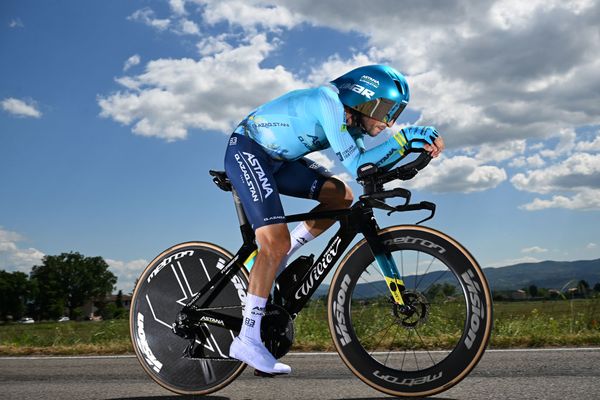Can you trust your power meter?
Understanding the limitations of your training tool can help you get the most from it
Alex Hunt
Junior Tech Writer
Power meters are often seen as the ultimate training tool. They provided objective data that is not affected by external factors that afflict heart rate such as fatigue, caffeine and hydration. Power meters aren’t without their own limitations, however. Alex Paton looks at how reliable and trustworthy power data really is.
What types of power meters are there?
Power meters come in all shapes, sizes and costs. Depending on the type of power meter, the cost can vary wildly with some of the cheapest options on the market costing a few hundred £/€/$ and with some of the flagship options sailing well over £/€/$1000.
Read more: Getting the most out of your smart trainer with training zones
Pedal-based meters
Measuring power at the pedals is the hardest place to accurately get a reading as they are open to many different input forces. They are also the most susceptible to damage from knocks and wear which can cause them to mis-read.

© GCN
Pedal-based power meters are the easiest type to install
Pedal-based power meters are, however, the most convenient to swap from bike to bike as they simply screw in like a regular pedal without the need for any additional modifications.
Crank or spider-based meters
These are often regarded as a more accurate option than pedals as the meter itself is either installed on the crank arm or on the spider that the chainring mounts to. These are harder to install than pedals but their location does protect them from damage.
.jpeg?w=1348&auto=format)
© GCN
A crank or spider based power meter is less susceptible to damage than a pedal-based meter
As a general rule, cranks or spiders originally designed to be a power meter from the ground up will be more accurate than units that have had the power meter unit retrospectively fitted.
Hub-based meters
Power meters in the hub of a rear wheel are the easiest place to accurately measure power as there are fewer input forces to work with. The issue with hub-based meters is that they can be very costly to install and can limit your choice of wheels.
.jpeg?w=1348&auto=format)
© GCN
The location of a hub-based power meter can make accurate measurement easier than other types
Due to its location further down the drivetrain, hub-based power can read lower than the other meters. This is because it takes into account the efficiency losses of the drivetrain between the rider's input and the cassette.
Single or dual-sided?
When it comes to pedal or crank-based meters most brands will offer either a single or a dual-sided option. Single-sided meters are often considerably cheaper as they only use strain gauges on one side of the bike to measure a rider's output. To get the total power the unit then simply doubles this reading. This method does open the data up to a fair bit of inaccuracy as most riders do not pedal with a perfect 50/50 split.

© GCN
Dual-sided power meters are more accurate than single-sided
Dual-sided meters on the other hand measure the individual inputs of each leg. This gives a far more accurate total power reading and also allows riders to dig deeper into their pedalling dynamics. Dual-sided meters are some of the more pricey units on the market but for those looking for accurate readings then this is the way to go.
Read more: New dual-sided 4iiii power meter weighs just 29g
How accurate is a power meter?
This depends on the specific meter that you have. Most power meters will have a quoted accuracy of between 1-5% meaning that if you are riding at a displayed 300 watts, using a power meter with an accuracy of +/-1% you could actually be riding between 297 and 303 watts. With a meter with a claimed 5% accuracy this balloons to between 285 and 315 watts.
This is why it can be very hard to compare power with other riders because there could be such a margin of error. If two riders are both using a power meter with a claimed accuracy of 5%, there could be a 30-watt difference between the two however both could be giving a reading of 300 watts.
Accuracy or consistency?
This is where things can get a little bit more confusing. When using a power meter as a training tool the consistency of its reading is more important than its accuracy. Even if your power meter under-reads significantly, as long as it consistently under-reads daily, the data will be comparable. This is a better situation to be in than having a power meter that reads more accurately but can vary by how much from ride to ride.
The main thing a power meter is used for is tracking progress. If you have an inconsistent power meter it can have the effect of making you feel like you have been stagnant when in reality you have been progressing. Or, it can show significant gains when there has only been a slight improvement. Having a power meter that reads consistently regardless of the actual number it displays is more valuable than absolute accuracy.

© GCN
Having consistent data is better than accurate data that is all over the place
If you have multiple power meters — one on your bike and one on an indoor trainer, for example — it can be useful to understand the relationship between them. It is unlikely that two separate power meters will read exactly the same so knowing which one reads higher or lower than the other can help you adapt your training based on which meter you are using.
For example, if you typically train on an indoor trainer and this reads 10% higher than the power meter you use out on the road then you will need to consider this when setting your target power.
Read more: Why are cyclists obsessed with FTP numbers, and is it actually useful?
Another thing to consider is that not all power meters are linearly inaccurate. Some power meters will have a sloping inaccuracy meaning as the power increases so too does the level of inaccuracy. This is not to say that power meters aren’t worth using, but if you are serious about your training and want to better understand the numbers behind your efforts, power meter accuracy is an important consideration.
It’s not a matter of cost
It would make sense to think that the more you spend on a power meter the more accurate and consistent it will be. However, time and time again this has been proven not to be the case. There are plenty of independent power studies out there showing that some of the cheaper meters on the market have exceptional performance. The tests also reveal that some of the premium price meters do not have the performance to back them up.
Can anything be done to make power meters more reliable?
This once again depends on the individual unit with some manufacturers able to correct issues with the meter readings through a software update. If you find that your meter is not reading correctly it is worth reporting this to the manufacturer as this information can be used to help roll out updates that could fix the issue.
Something that you can do that will increase both the accuracy and consistency of the meter is perform a zero offset before your ride. This is essentially the same as pressing the tare button on a set of scales and resetting what zero is for the day, taking into consideration the temperature and small changes to the strain gauges. It is worth noting that this is not a calibration but an offset, even though some head units will label it as a calibration.

© GCN
Performing a zero offset before every ride will increase the reliability of the data
If you are heading out for a particularly long ride or if there has been a significant temperature change it can be worthwhile stopping and performing another zero offset as temperature changes can affect the reading of a power meter. Some more premium meters have active temperature compensation that will consider this, however, it is best to still carry out a zero offset from time to time.
You can calibrate some meters by hanging a specific weight from the cranks to provide a known load on the strain gauges. This allows them to properly calibrate to that given force. This is not something most of us are likely to do, and it can even increase the inaccuracy of the meter if not done correctly. If you want to fully calibrate your power meter it is advised that you reach out to the manufacturer of the meter to find out the exact procedure.
How big an issue is this really?
This depends on how much you want to take away from the data. If you use power as a pacing tool on a Sunday ride and to track general trends in fitness on the bike, none of this really matters.
The more specific you are looking to be with your training the more important some of these factors become. If you split your training between multiple bikes or between the indoor trainer and riding on the road, it is a good idea to spend some time learning about the discrepancies between each meter so you can tailor your training accordingly.
If you are trying to train in the most scientific way possible and want absolute data then this is going to require a huge investment in time. Even for the pros, this is not necessarily worth it.
For all the latest tech developments make sure to head over to our dedicated tech news section of the GCN website.











.jpg?w=600&auto=format)